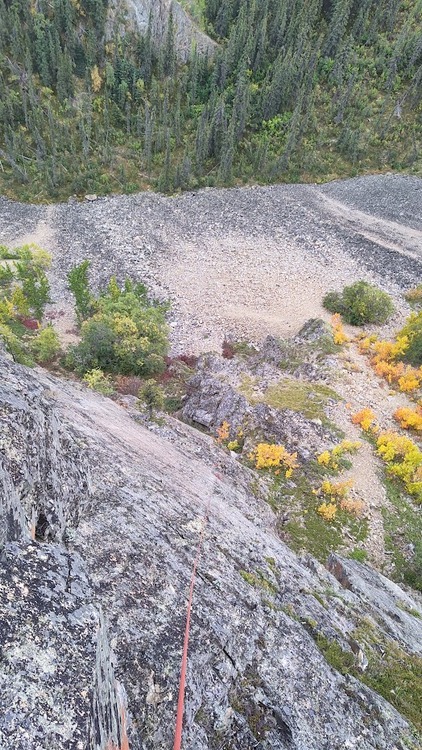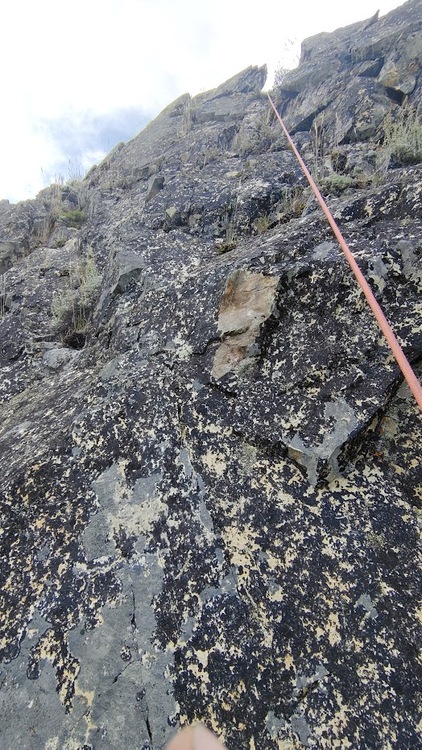Wedge bolts in sedimentary rocks?
|
|
Hey all, I'm hoping to develop some short multipitches on an undeveloped crag. Local geology map calls the rock "green and red greywacke and pebble conglomerate/mudstone". Most of the cliff is total choss but a section of it actually has the potential for 2-3 lines up decent rock in a beautiful setting not far from the city. All my bolting thus far has been in granite but I've clipped a lot of 3/8s bolts in limestone or other less bomber rock. But from my reading, I know that in softer rock 3/8s are considered less than ideal. In fact, it reminds me quite a bit of the rock in Snoqualmie Pass on the Tooth and the Fang (though that's volcanic), which 3/8s are definitely used on. Obviously, the ideal is glue-ins for this kind of rock but I don't want to spend a huge buck on lines that may or may not become popular. I'd rather establish the lines with affordable hardware now then if they become popular I, or someone else, can upgrade them. Much of the middle of the cliff looks to be pretty compact slab (pictures below) but the upper and lower sections are more fractured and sections are pretty easy to rip off. The plan is to obviously clean as much as possible first. I've heard people use 1/2" or 5 piece bolts in this sorts of rock but 5 piece bolts but I can't find any Canadian supplier for them and also seem to be very expensive. I can certainly access 1/2" wedge bolts from ClimbOn but I was curious what peoples thoughts are on choosing hardware. |
|
|
Long 1/2” 5-piece SS Powers are the best for those less-solid rock types. |
|
|
John, are there any experienced local developers around you that you could bring in and ask for advice? They may have even equipped the same kind of rock in the region and be able to tell you what they used and how it held up. In general I’m in agreement with George here - unfortunately poor quality rock requires high quality hardware if it’s reasonable at all. What you could try is placing a few practice bolts on boulders of the same quality on the ground and see how well they install/tighten up/etc and patch them once you’re done. That might give you an idea of how soft the rock actually is. |
|
|
Yea, like I said I can't seem to find anyone that actually distributes SS sleeve bolts in Canada.
No, this is the Yukon, not much of a development scene here anymore besides me and a few others. The old schoolers were putting zinc plated bolts in limestone with an inch of stud sticking out, so I'm not entirely confident on seeking their advice. Most of my mentors are back in the Rockies, where they've been placing 3/8 wedges in shitty limestone for ages (and before that the norm was 1/4 with homemade hangers lol). No development, as far as I know, on this kind of rock in the area. Though other areas have conglomerate rock and just use standard 3/8s wedges from the looks of it, no issues there thus far but I doubt its a spot where lots of whips have been taken to actually test that. I've thought about just doing some test bolts, as you said, since I access the cliff top down off tree anchors and I'd likely be putting in some temporary bolts for directionals as I clean and work the route anyway. But not sure I could produce enough force to actually test them properly. Beyond 3/8 or 1/2 wedges the only other feasible option is just biting the bullet on glue-ins I guess. On a bolt basis they'd be cheaper than importing 5 piece sleeves but no clue how much of a cost factor the resin is. If someone from Canada chimes in with a source for affordable SS sleeve bolts that'd be awesome. |
|
|
I would think that longer (4 to 4 1/2 inch) 1/2 inch SS wedge bolts would work well for your application. I am most familiar with bolting the metamorphosed sandstone in the Algoma region on the North Shore of Lake Huron. Most work is done with 3/8 inch SS wedge bolts but we will bump it up to 1/2 inches on more questionable sections of the cliffs. Given the probable usage level for your proposed routes I don’t think a Cadillac solution is necessary. |
|
|
i would recommend glue-ins: https://www.team-tough.com/twist-bolts-4 https://fixehardware.com/index.php/fixe/climbing-hardware/glue-in-bolts.html either of those will work well... |
|
|
I obviously can't speak to your rock specifically but we have a small amount of greywacke here as well and when I was looking into this question, greywacke was usually mentioned in the same breath as granite with regards to hardness and bolting. The defining features of greywacke are the poorly sorted sediment grains and the hardness. Mudstone is trash and is likely the "total choss" from the rest of the cliff. I would probably avoid drilling any areas with larger grains but the fine gain areas should be good. I've only put in a two bolt TR anchor with extremely low consequences from a catastrophic failure but I felt very comfortable using 3/8" wedge bolts. I would also recommend placing gear when possible. I usually bolt in soft limestone with glue ins so the start up cost of the required tools was not a factor for me. |
|
|
John Serjeantson wrote: Glues such as Ac100 and A5 are pretty affordable $15-20 a tube, at least in the US. They also come in a standard caulking gun tube size. I usually get 10-15 bolts a tube. Even if you could source long 1/2 SS powers they are like $15 here, not including a hanger which makes glue ins (including glue) about half the price. |
|
|
If you look at MEC's website, you pay for a hanger and a 3" bolt $9.90 Canadian. You can get a tube of Sika AnchorFifix 2020 off Amazon.ca for $31.60. Depending on the type of glue-ins you use (some displace more than others) and how precisely you drill your holes (depth), you should get around 15 bolts per tube (likely not the first time, but once you got the hang on it). That brings you to about $11.50 per bolt for glue-ins vs. $10 for mechanical bolts. The glue-ins, if installed properly will last longer, be stronger and won't need any maintenance (e.g. loose hangers after freeze thaw cycles) compared to mechanical bolts, so it is up to you to decide if the little bit of extra money spent is worth it or not. |
|
|
Tobias Link wrote: Hmm I see $9.95 broooo I don't think I can handle that kind of cost ;) Just kidding, but good point. Ultimately the cost isn't that much of an increase. What's the best cheap tactic to set these up for multipitch rappels? I don't see any 'ring hanger' style bolts. Just two quick links per bolt on the anchor? |
|
|
John Serjeantson wrote: Two quick links per bolt will work. One draw back is that depending on how har apart the bolts are you will get a pretty severe twist in your rope with that set up, not tragic just a pain in the butt. Ive been doing a short length of chain on each bolt to eliminate that. |
|
|
My personal go-to set up for stations/anchors is similar to what you can see here: https://climbonequipment.com/products/grandwall-equipment-asymmetrical-belay-station As I make them myself I have the glue-ins instead of the hangers and use quick links instead of the two rings you see in the picture. In addition, I add an additional rap ring/quick link into the lower quick link so the ring/quick link which people will thread their rope through sits perpendicular to the rock surface preventing the rope rubbing against the rock. So the cheapest version only needs two quick links and a piece of chain. The "premium" version needs another quick link or a rap ring for the bottom in addition. By doing it yourself, you can adjust the length of the chain if you need more distance in between the two bolts because of rock quality or space restrictions. Make them at home, then when you are out, drill the bottom hole first, stick the bottom bolt into the dry hole and you can use it as a "template" to figure out where to drill the upper hole. If done carefully, you won't have a lot of slack, if any, in the chain. Hope the description is clear enough. |
|
|
Tobias Link wrote: Yep, I've seen this a lot and thought about doing it myself since it's clearly the ideal set-up but again, it comes down to limited funds. I made the decision to just do all my anchors as two offset rings without a chain since the only advantage I really see with the chain is easier anchor set-up on multis and no shock-loading in the event the upper bolt blows when rapping/lowering (which isn't really a genuine concern imo). Saves me a bit of money this way, even if its not nearly as clean. Thank you for the suggestion though. I think pre-emptively setting the bolts up offset with two quicklinks each (or a quicklink and a ring) so the rope doesn't twist might be what I do, then in the future a chain can be added if desired. |
|
|
In W. OR, we've been placing bolts in Tyee sandstone greywacky. Observations after 30 yrs, plated bolts are needing replacement, SS are still going strong. Things to consider, the strength of the Rock you're bolting is totally dependent on the thickness of the rock's patina you're bolting in. Stick to the patina and stay away from your light colored rock. In solid Rock any diameter SS bolt has worked we'll. My preference has been at least 3+" depth. And if you're thinking SS maybe consider glue-ins. Have fun! |
|
|
Hi John, I’ve been developing quite a bit at our local sandstone crag. Although glue are by far the best choice if you want to use bolts and hangers; I would suggest DeWalt POWER-BOLT® STAINLESS STEEL HEX HEAD 3/8 3 1/2 inch. |

 Continue with onX Maps
Continue with onX Maps Sign in with Facebook
Sign in with Facebook






















